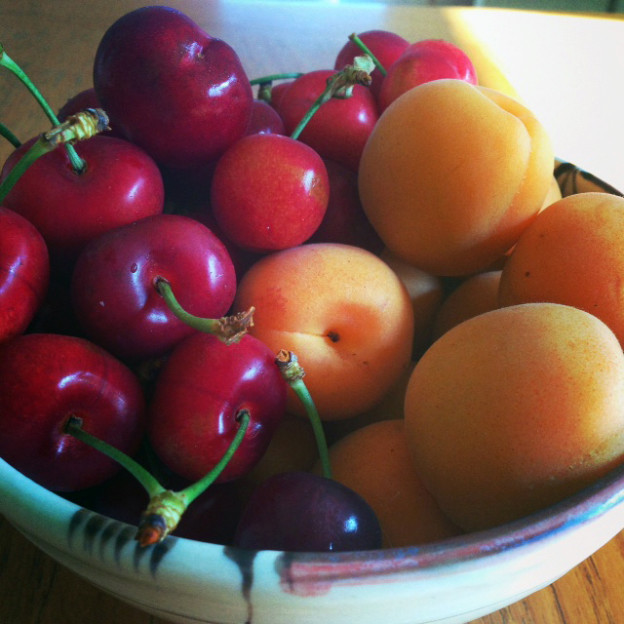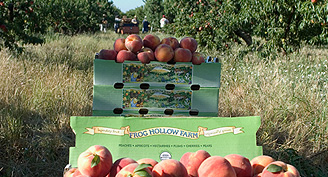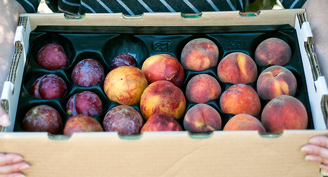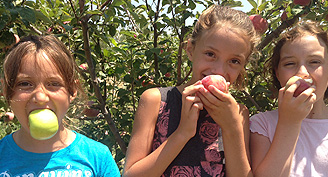This Week's Fruit
Brooks Cherries
Frog Hollow Farm, Brentwood, CA
Named for the Turkish town of Cerasus, cherries have been cultivated since about 300 BCE. In 1912 they came to the U.S. by way of Japan, as a gift of friendship from the people of Japan. The Brooks Cherry was developed at U.C. Davis in the 1980’s. Though early to arrive, Brooks don’t sacrifice taste, color or texture. They resemble a Bing with a more balanced sweetness in their dark, rich flesh. WE CAN REUSE THE CLAMSHELLS - please send them back with your boxes!
Apache Apricots
Frog Hollow Farm, Brentwood, CA
The Apache is one of the newest varieties of apricots introduced to growers and was developed by the USDA Agricultural Research Service. It’s early off the tree, and like our Brooks cherries, doesn’t sacrifice any flavor or texture to beat its more popular cousins off the branch. Apache’s skin is pinkish-orange, with an orange flesh that is finely textured.
Super Zee Peaches
Frog Hollow Farm, Brentwood, CA
Native to China, peaches of legend conferred immortality and were treasured by ancient Emperors. In the early 17th century a horticulturist by the name of George Minifie is said to have brought the first peaches from England to the United States, planting peach trees at his Estate of Buckland in Virginia. Peaches now grow throughout the world’s temperate regions, but find a uniquely suited home in Brentwood’s Mediterranean climate.
Navel Oranges
Etheridge Farm, Dinuba, CA
California Navel Oranges are considered to be the best Navels for eating out of hand. They have a thick skin that is easy to peel, are seedless, and have a meaty and sweet flesh that makes them a perfect snack. Navels are also great for
juicing and cooking.
A Note from Farmer Al
Dear CSA Members,
Every week we interact with nature in a different way here on the farm. Most of the time our trees (and us, too) are benefitting from the particular natural environment that is Brentwood….our terroir, our farm ecology. But of course there are always challenges too.
These last few weeks there have been two “things” of nature that “eat” (damage) our fruit, one is very obvious and the other is almost invisible.
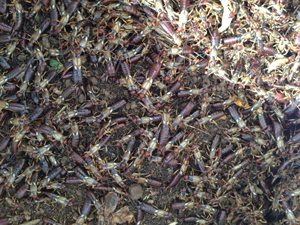
The obvious one is the earwig. These monster-like critters live in the soil. At night they sneak up into the trees and forage for fruit, gouging big craters (1/4” – 3/8” deep and in diameter) into the fruit and rendering that piece of fruit unsalable. When they come back down to the ground they will look for a warm dark place to hide. My ground crew gives them their “cave”, which is actually a 12” length of “drip tubing” (irrigation hose). We place these black tubes at the foot of each tree at about mid-April, then we go around each morning for several weeks, carefully picking up each tube and tapping out into a bucket any earwigs that are hiding there. We collect “thousands” of them each day. Over the weeks we reduce the earwig population significantly, thereby saving more fruit for us to eat and winning this skirmish of the never-ending competition for food that is the essence of all life on earth.
The other foe we face is fungus; invisible to our eyes until the effects of their foraging is seen much later in the scars on the skins of the fruit. It is cosmetic damage only, but since we humans eat “with our eyes”, these scars make the fruit less desirable, and hence unsalable. So we must also wage war with this particular fungus, and try to prevail on yet another front in the eternal fight for food. For this we use sulfur, a natural material, mined from the earth, which inhibits the ability of the mildew fungal spores to develop on the skin of the fruit. It acts as a barrier.
It’s all about food and the intricate food web (war) which connects every species on Earth.

 The obvious one is the earwig. These monster-like critters live in the soil. At night they sneak up into the trees and forage for fruit, gouging big craters (1/4” – 3/8” deep and in diameter) into the fruit and rendering that piece of fruit unsalable. When they come back down to the ground they will look for a warm dark place to hide. My ground crew gives them their “cave”, which is actually a 12” length of “drip tubing” (irrigation hose). We place these black tubes at the foot of each tree at about mid-April, then we go around each morning for several weeks, carefully picking up each tube and tapping out into a bucket any earwigs that are hiding there. We collect “thousands” of them each day. Over the weeks we reduce the earwig population significantly, thereby saving more fruit for us to eat and winning this skirmish of the never-ending competition for food that is the essence of all life on earth.
The other foe we face is fungus; invisible to our eyes until the effects of their foraging is seen much later in the scars on the skins of the fruit. It is cosmetic damage only, but since we humans eat “with our eyes”, these scars make the fruit less desirable, and hence unsalable. So we must also wage war with this particular fungus, and try to prevail on yet another front in the eternal fight for food. For this we use sulfur, a natural material, mined from the earth, which inhibits the ability of the mildew fungal spores to develop on the skin of the fruit. It acts as a barrier.
It’s all about food and the intricate food web (war) which connects every species on Earth.
The obvious one is the earwig. These monster-like critters live in the soil. At night they sneak up into the trees and forage for fruit, gouging big craters (1/4” – 3/8” deep and in diameter) into the fruit and rendering that piece of fruit unsalable. When they come back down to the ground they will look for a warm dark place to hide. My ground crew gives them their “cave”, which is actually a 12” length of “drip tubing” (irrigation hose). We place these black tubes at the foot of each tree at about mid-April, then we go around each morning for several weeks, carefully picking up each tube and tapping out into a bucket any earwigs that are hiding there. We collect “thousands” of them each day. Over the weeks we reduce the earwig population significantly, thereby saving more fruit for us to eat and winning this skirmish of the never-ending competition for food that is the essence of all life on earth.
The other foe we face is fungus; invisible to our eyes until the effects of their foraging is seen much later in the scars on the skins of the fruit. It is cosmetic damage only, but since we humans eat “with our eyes”, these scars make the fruit less desirable, and hence unsalable. So we must also wage war with this particular fungus, and try to prevail on yet another front in the eternal fight for food. For this we use sulfur, a natural material, mined from the earth, which inhibits the ability of the mildew fungal spores to develop on the skin of the fruit. It acts as a barrier.
It’s all about food and the intricate food web (war) which connects every species on Earth.


